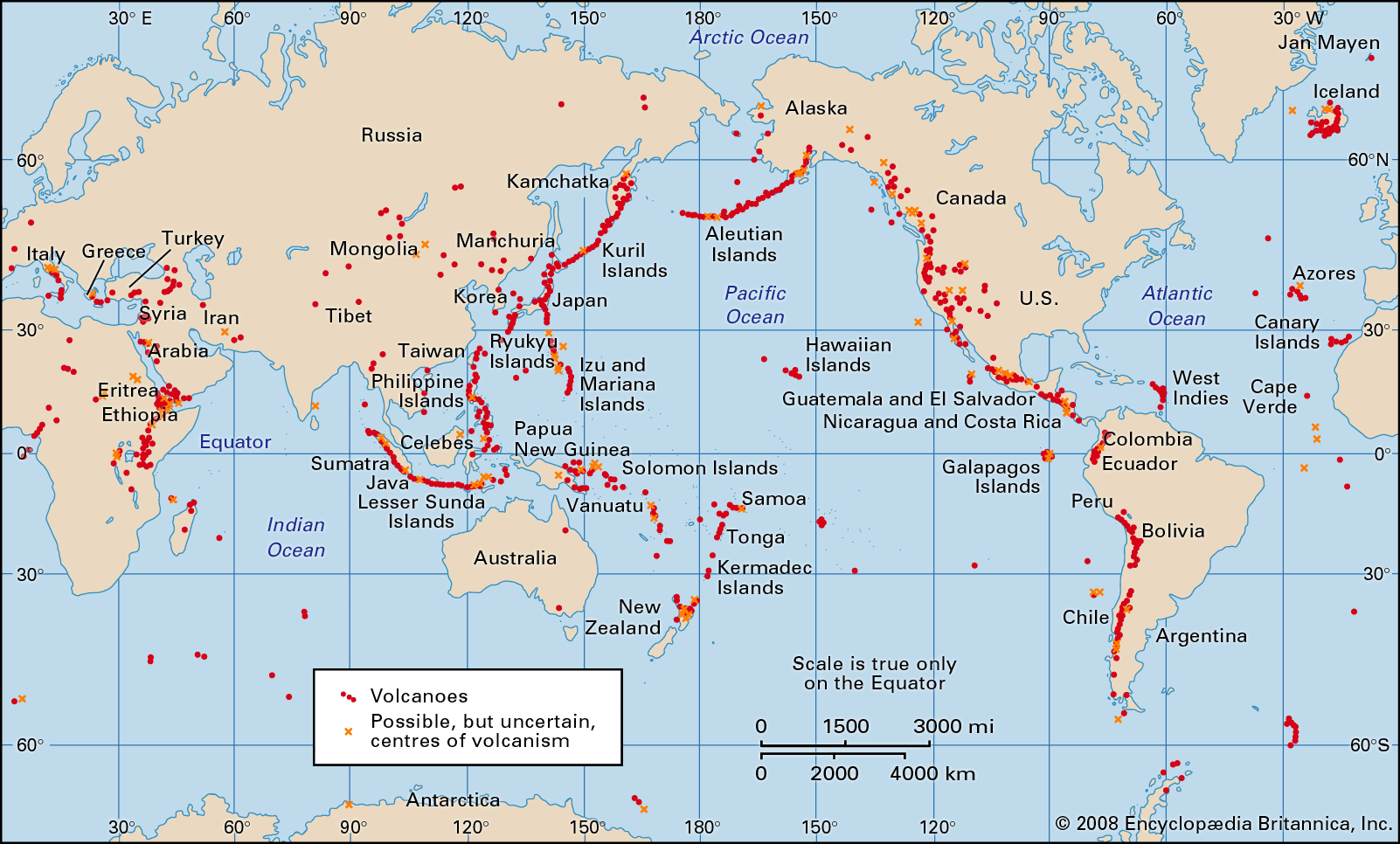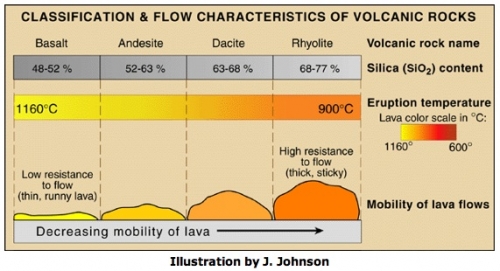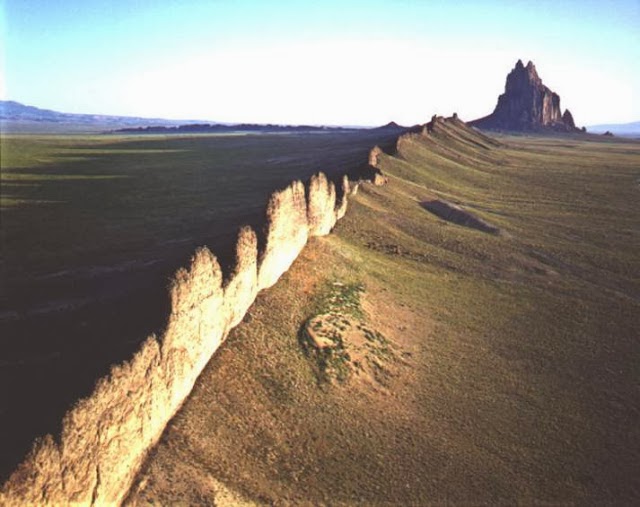5.4 - Volcanism
Watch: Instructor's Video Links to an external site.
Volcanoes

A volcano is considered active if it has erupted at least once within historical times and is considered likely to do so again. There are about 550 active volcanoes in the world. On average, about 15 of them will erupt this week, 55 this year, and perhaps 160 this decade. There is likely to be one or two eruptions per year from volcanoes with no historic activity. In addition to surface eruptions on continents and islands, there is a great deal of undersea volcanic activity - 75 to 80% of all volcanic activity is estimated to occur beneath the oceans.
Within the lower 48 states, prior to the 1980 eruption of Mt St Helens, there was only one volcano classified as active - Lassen Peak which last erupted in 1917. A number of other volcanoes, including Mt Shasta, Mt Baker and Mt Rainier show signs of potential activity. Both Alaska and Hawaii have many active volcanoes.

Volcanic activity is primarily associated with plate boundaries - both divergent and convergent. The most notable area of volcanism in the world is around the margin of the Pacific Ocean in the Ring of Fire. About 75% of the world's volcanoes are associated with the Pacific Rim. They are there because of the subduction zones which ring the Pacific Ocean.

The nature of a volcanic eruption is determined largely by the chemistry of the magma that feeds it. How much silica is in the magma is important. High silica, felsic magmas (think melted continental crust) tend to be sticky or have high viscosity. Gas is trapped in these lavas under great pressure. The result is violent eruptions in which large quantities of pyroclastic material (very hot ash, lava fragments, and gases) are ejected from the volcano. Any lava flows are likely to be very thick and slow moving.
On the other end of the spectrum, is mafic magma (think basaltic oceanic crust). This magma is hotter and more fluid. It holds significantly less gas under pressure. The resulting eruptions usually include a lot of liquid lava.
Magma types encompass a spectrum and what I've just described are the two ends of that spectrum. Many volcanoes have characteristics that fall somewhere in the middle. Sticking with this focus on the extremes, lets talk about two types of volcanoes: Shield and Composite.

Shield Volcanoes

These volcanoes are on the mafic end of the spectrum with low silica content and low viscosity (they aren't sticky). Basaltic lava tends to flow easily over the surrounding landscape forming, broad, low-lying shield volcanoes. (shaped like a shield -hence the name). This lava flows sorts of like pancake batter poured onto a griddle. These volcanoes are built up layer upon layer of solidified lava flows with relatively little pyroclastic materials. Some shield volcanoes are very tall but they are never steep sided.
The Hawaiian Islands are composed of numerous shield volcanoes. Mauna Loa on the Big Island is the world's largest volcano - it is more than 6 miles high from its base on the floor of the ocean to its summit.
Composite Volcanoes

Composite volcanoes, also called stratovolcanoes, tend to develop symmetrical steep sided volcanoes. These types of volcanoes are the type Hollywood likes best for movies.These mountains build up steep sides by having layers of ejected pyroclasts from explosive eruptions. Pyroclasts are a mixture of hot rock fragments, hot gases, and entrapped air that is ejected from these volcanoes. Composite volcanoes are on the other end of the spectrum from Shield Volcanoes with sticky, high viscosity, high silica content, felsic lava - holding gas under pressure. The tend to explode violently. The pyroclasitc material builds up through successive eruptions, creating the steep slopes. Famous examples are Mt St Helens, Mt Fuji, Mt Rainier, and Mt Pinatubo.
Calderas

Periodically, when a composite volcano erupts, it will erupt so violently that the volcano explodes, collapses or does both. The result is a huge basin shaped depression - a caldera. The most famous caldera in North America is Crater Lake in Oregon. About 7700 years ago, Mount Mazama was a 12,000 foot volcano. It erupted so violently that the upper 4000 feet of the peak exploded and collapsed back into the magma chamber leaving behind a depression that ultimately became Crater Lake. There are many calderas around the world: for example, Ngorongoro Crater (Tanzania), Santorini (Greece), Lake Rotorua (New Zealand), Mt Tambora (Indonesia), Dakantou Caldera (Japan), Lake Llopango (El Salvador), La Primavera Caldera (Mexico).
Intrusive Vulcanism
When magma solidifies below the Earth's surface, it is intrusive volcanism and produces igneous rock. If this rock is pushed upward into the crust either before or after it solidifies, it's called an igneous intrusion. Sometimes an igneous intrusion is pushed up high enough to deform the surface. Igneous intrusions are sometimes exposed by erosion and become visible to us.
Batholiths

A batholith is a large igneous body (at least 40 square miles). They often form the core of major mountain ranges and their uplift is a part of mountain building. There are batholiths at the core of the Sierra Nevada, the Sawtooth Mountains in Idaho and the Front Range in Colorado.
Stocks and Laccoliths

Stocks are similar to a batholith but smaller. Laccoliths form where slow moving magma squeezes between horizontal layers of pre-existing rock. . The magma builds up a mass , pushing up the surface. A number of famous mountains have laccoliths at their cores - the Henry Mountains in Utah, the Black Hills in South Dakota.
Dikes, Sills and Veins
Dikes are probably the most widespread intrusive volcanism. They form when magma forces itself into vertical fractures in pre-existing rock. They are vertical and narrow and often resistant to erosion. A sill is a long, thin intrusive feature where magma has seeped into horizontal fractures in rock. Veins are small and can be any direction, again where magma forces its way into existing fractures in rock.
From left to right, below are photos of a dike, sill and vein.

